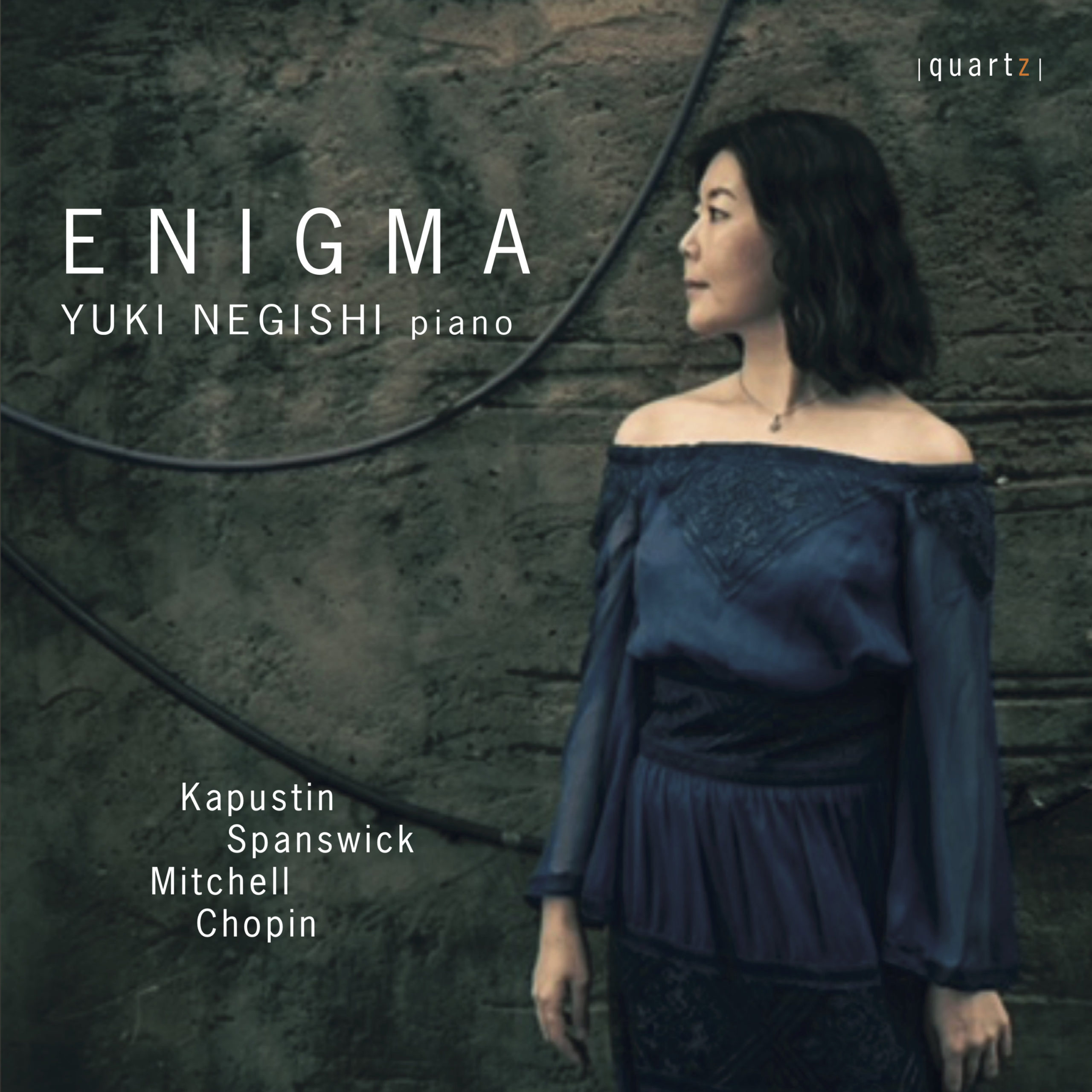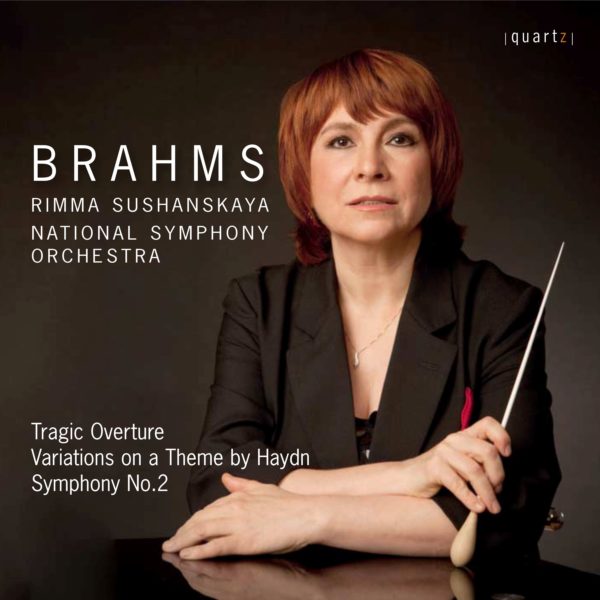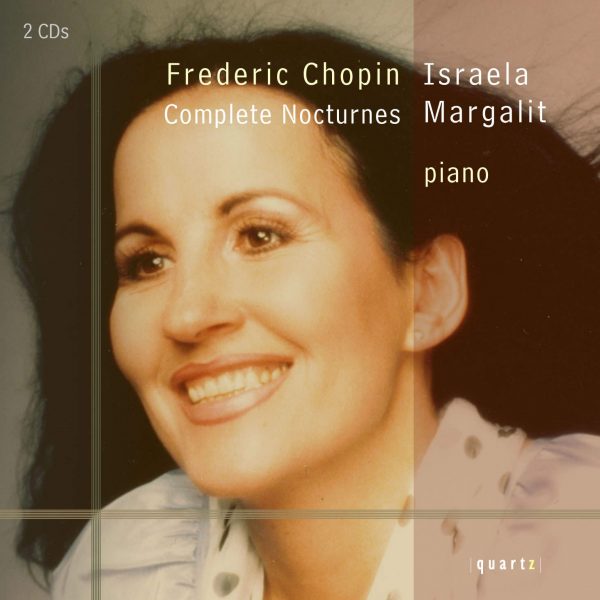Enigma
Price range: £7.99 through £16.99
The brilliant Nikolai Kapustin wrote music for himself. The tiring sense of having to explain the exact place where the divide between his obvious deep love and influence of Jazz and Classical lies must have left him feeling resentful of ever agreeing to talk about his unique work. Kapustin simply did not wish to put energy into it – compared to the actual act of composition. And that answer is – there is not a divide – so perhaps listening without a divide can put us closer to the magical place from which he operated. A place that could only come from infinitely curious spirit, a famously rigorous Classical training in Russia, and not only an influence but a love and highly developed Jazz talent – combined – but expressed primarily through a Classical means. Melanie Spanswick, composed in February 2019, especially for Japanese pianist Yuki Negishi, is a miniature programmatic work that inhabits an atmospheric, dreamy sound world. It employs the full range of the keyboard and seeks to showcase the enigmatic resonance of the instrument.
About This Recording
Nikolai Kapustin (1937 – 2020) Sonata No.1 Op.39 “Sonata-Fantasia”
The brilliant Nikolai Kapustin (as stated in his initial interviews in the West) wrote music for himself. The tiring sense of having to explain the exact place where the divide between his obvious deep love and influence of Jazz and Classical lie – must have left him feeling resentful of ever agreeing to talk about his unique work. The more I hear his music the more I am convinced that the answer lies in front of us – Kapustin simply did not wish to put energy into it – compared to the actual act of composition. However that answer is – there is not a divide – so perhaps listening without a divide can put us closer to the magical place from which he operated. A place that could only come from an infinitely curious spirit, a famously rigorous Classical training in Russia, and not only an influence but a love and highly developed Jazz talent – combined – but expressed primarily through a Classical means. Fully aware of the strong improvising component in Classical music history – this would perhaps naturally be a casualty as the love of performing per se decreased and gave way to only composing and recording. Not even Jazz would awaken the chances of seeing him improvise in real time (in either fashion). A real shame! The worlds do not collide here or work across a divide – they coexist and take effortless sculpted turns to speak or harmonise.
i Vivace Like an Escher etching – depending where your ear is – there are moments where we flip between the improvised intro to a contemporary Jazz trios’ take on a standard – and the midst of a late 19th to mid-20th Century Russian piano concerto solo exposition. Sometimes within a bar. The imagery of the Jazz club and concert hall are thus in constant dialogue or superimposed. The clues are in the absolute assurance of form, the absence of improvisatory risk – but the spirit of a frozen extemporisation is nevertheless – very strong.
ii Largo The tranquil echoes of a Gershwin/Ahmad Jamal/Bill Evans rumination. Its mood and heart beat regulated by minuscule undulating movement of a single alto voice. This is accompanied by a walking bass that can morph into a Scriabin arpeggio at will. Midway through, a lower octave/unison motif allows the flow to quickly change pace and direction into larger textural gestures of quartal harmony exclamation (on a blues foundation) – before falling gently to return towards the initial mood through a doorway swinging between B major and
E minor.
iiiScherzo. Vivace A symphonic partial tango glowing through all the colours of the region of its origin. A powerful melody demands and bears repeated statement across registers and multiple perspectives – and sometimes in echo formation. The last quarter (memory of a samba) allows a variation to fragment into a linear tangent – with an acciaccatura wink landing in A major (making the preceding flowing complexity vanish in a puff of smoke).
iv Allegro Molto Multiple pentatonic formations duel around the huge chords of a Broadway finale. Waves of hope intersect, unify, interrupt, and defract. Echoes of the Chopin revolutionary étude give way to a bass-line asymmetrically inflected with Nancarrow styled micro-allusions. A self-similar melody dancing intertwined in two worlds at once. A momentary pause and a turn on a dime – before an expansive intake of scalic fantasy in multiple directions. A four-note seed is the key to the song without words that brings this wonderful kaleidoscopic voyage of a Sonata to a close. A strong statement of maturity in what was only the fourth solo piano work from Kapustin.
Melanie Spanswick (1969 – ) Enigma
Composed in February 2019 especially for Japanese pianist Yuki Negishi, this miniature programmatic work inhabits an atmospheric, dreamy sound world. It employs the full range of the keyboard and seeks to showcase the enigmatic resonance of the instrument.
The essence of the enigma, which manifests itself in the melancholic mood, alludes to a tragic love affair, which might remain forever elusive. However, the sudden switch to the major key at the end of the piece offers some hope and a possible joyful conclusion.
After enjoying several performances given by Yuki, I noticed the virtuosity and ferocity of her left hand particularly; she possesses a fine technique with a direct, fresh approach to interpretation, and these qualities inspired and guided my composition. The speed, intricacy and patterned nature of the left-hand part, coupled with powerful ringing chords in the right-hand part, offer the yearning character found throughout this work. The performance on this recording captures this spirit admirably.
Yuki gave the premiere of Enigma in April 2019 at the Symphony Salon in Tokyo, Japan, as part of the International Festival and Piano Course, Piano Week, and she has played it on several occasions since, both in the UK and abroad.
Enigma is published by Schott Music in a volume entitled Simply Driven (ED 23222). This collection, published in the Edition Schott Composer Series, consists of five virtuoso piano pieces, all of which explore various piano techniques and sound worlds.
This recording marks the recorded premiere of the piece, and is also the first commercial release for myself as a composer.
—Melanie Spanswick, Nov 2021
Robert Mitchell (1971 – ) Our Hearts Dance The Infinite (As The Giant Puya Blooms)
The Giant Puya blooms rarely. An astounding flower whose moment is more than worth the wait. The image came to mind once I had been given the backstory to the wonderful opportunity of a commission from the London Sinfonietta. A love story that had taken more than two decades to come to fruition – with no obvious guarantee that it would. A similar timescale to the Puya. I combined this with a musical love of mine that had taken even longer to come forward – left hand only piano (composing, performing and improvising). A format that demands (and should get more limelight for) the revealing of a side of ourselves too often hidden behind convention (unless no other choice or sudden change of physical circumstance demands). A whole world of inspiration lies behind what is actually in pianistic terms – the illusion of one hand.
I would like to thank Yuki for the inclusion within this wonderful programme and for the beautiful world premiere recording. Dedicated to Anthony Rawlinson. With thanks to Andrew Burke (Artistic Director – London Sinfonietta).
Frédéric Chopin (1810 – 1849) Berceuse in D flat Major Op.57
One of the later pieces produced by a sublime creativity. A ‘cradle song’ balanced upon a consistent quiet dynamic, an insistent back and forth rocking harmonic motion, and a persistent connection to the infinite. A mastery of variation – delineating a melody that delights in its own reflection and subsequent evaporation into multiplicitous points of departure. The sixteen views of tranquility see well into an impressionistic future. A future that Chopin could intuit through a sound without end – from such a limited lifetime on earth. Hence, one of his most poignant quotes: “One can’t have everything in this world; be content with the greatest of joys: health.”
Frédéric Chopin Sonata in B flat Minor Op.35
Completed in 1839, this four-movement Sonata has taken a long time to assume its rightful place as one of the great works in the format. Four movements that shook more than a fist at what had been the dominant piano statement in preceding decades (fading by the time of publication in 1840).
i Grave. Doppio movimento The first and second movements share a sense of both riding on waves of unease and urgency. The debated first movement repeat from the start is included here. Dynamic, direction and texture in constant flux.
ii Scherzo. Più lento The second movement partially pre-empts the opening of the majestic Polonaise in A flat, Op.53. The balladic trio section utilises a placid patient conversation between voices in an illusion of a large oasis that is soon brought back to earth.
iii Marche funèbre. Lento Edouard Ganche wrote that the infamous Funeral March that is the third movement ‘was like a song of agony for his country.’ The pain and longing – rendered Chopin speechless after performing it. Schumann heard “cannon concealed amid blossoms”. The second half of his life spent hoping for a return to Poland was never to be realised.
iv Finale. Presto The last movement – is a storm incarnate. The portrayal of individual waves pushing against the spirit that dares to even think it could survive the onslaught. Perpetual motion – the hands in parallel sculpting a path through the severe weight. Denial of a peaceful existence in his country of birth. Severely poor health from teenage years. Anton Rubinstein remarked that this resembled “wind howling around the gravestones”. The sound of an undeniable eternal beauty broke through these clouds of doom – regardless.
Bill Evans (1929 – 1980) Peace Piece
Bill Evans improvised an immortal moment. This was last thing on the recording schedule – once the trio had gone home – needed to complete the album “Everybody Digs Bill Evans” (1958). A timeless mix of the influence of Chopin, Debussy, Ravel, Messiaen and (I would definitely add) the great George Russell. Originally meant to be an introduction to Leonard Bernstein’s ‘Some Other Time’ – Bill opened a portal to a cosmos all of its own (that has remained influential ever since). The link with Chopin – which can be seen when comparing with the Berceuse on this album – is overt. A left hand figure that is complete in its simply being and mediative in its intent. A right hand that weaves ever more detailed and complex portrayals of synapses being freshly formed through the ether.
I mention George Russell as they had a profound respect (Bill loved working with him and the side of him it brought out). This contains both the overtly tonal and what has often been referred to as polytonal or even abstract. If we remove the barriers that are put up by the usage of those words – and remember it is all happening in the same universe then – we are left with types of sound relationships that are so distant they seem to belong to different planets. Chopin heard this ahead of his time. George Russell certainly did (as the gravity and close to distant tonal organisation in the Lydian Chromatic concept more than demonstrate). Oliver Messiaen heard the intricacies of birdsong – as far from abstract. Pianist/composer Hasaan Ibn Ali is an overdue but essential part of this lineage of hearing beyond time. Bill found a stunning point of balance on this scale of listening. From here to the beyond and from here to peace.
—Robert Mitchell, 2021
Track Listing
- I - Vivace
- II - Largo
- III - Scherzo. Vivace
- IV - Allegro molto
- Enigma
- Our Hearts Dance the Infinite (As the Giant Puya Blooms)
- Berceuse in D flat Major Op.57
- I - Grave. Doppio movimento
- II - Scherzo. Pui lento
- III - March funebre. Lento
- IV - Finale. Presto
- Peace Piece
Nikolai Kapustin (1937 – 2020): Sonata No.1 Op.39 “Sonata-Fantasia”
Melanie Spanswick (1969 – ): Enigma (2019) Dedicated to Yuki Negishi
Robert Mitchell (1971 – ): Our Hearts Dance the Infinite (As the Giant Puya Blooms) (2020)
Frédéric Chopin (1810 – 1849)
Sonata in B flat Minor Op.35
Bill Evans (1929 – 1980)
Tks 5 and 6: world-premiere recordings




